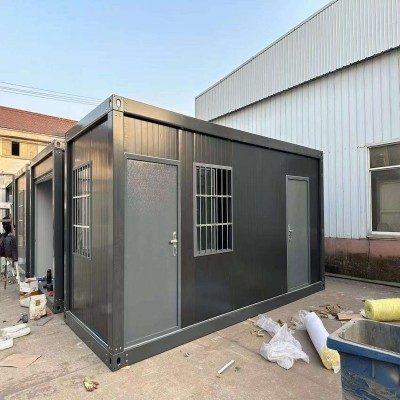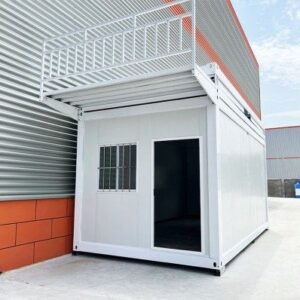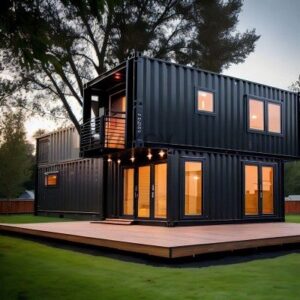The Typical Lifespan of a Container House
When you ask, How Long Container House Last?, the answer generally ranges between 20 to 50 years or more, depending heavily on several factors like climate, maintenance, and usage. Shipping containers are originally designed for durability in harsh international shipping environments, so when converted into homes, their structure can last decades.
How Climate and Usage Affect Longevity
The environment plays a major role in container house durability. Here’s how climate impacts lifespan:
- Humid and coastal areas: Higher risks of corrosion and rust due to salt air and moisture, which can shorten a container home’s life without proper anti-corrosion measures.
- Extreme temperatures: Heat can cause steel to expand and contract, potentially leading to structural stress or insulation issues.
- Dry climates: Tend to be less harsh on steel, allowing for longer-lasting container houses.
- Usage intensity: Frequent modifications or heavy interior loads can affect structural integrity over time.
Container Homes Versus Traditional Housing Lifespans
Compared to traditional homes, container houses hold up quite well:
| Housing Type | Average Lifespan | Notes |
|---|---|---|
| Shipping Container Home | 20 to 50+ years | Dependent on steel quality, maintenance, and climate conditions |
| Traditional Wood Frame | 50 to 100 years or more | Requires regular maintenance to avoid rot, pests, and wear |
| Brick or Concrete | 75 to 100+ years | More resistant to weathering, but costly and longer build times |
While traditional homes generally last longer, container homes designed and maintained well can offer comparable durability with modern improvements. Container homes have the added benefit of quick construction and superior modular flexibility.
For those curious about construction details and costs, see how to turn a shipping container into a house.
In , a properly built and cared-for container home, especially one using high-quality steel and corrosion-resistant coatings, can serve as a lasting and viable housing solution for decades under the right conditions.
Key Factors Influencing the Lifespan of Container Homes
The durability of a container house depends on several important factors that can either extend or shorten its life. Understanding these will help you make informed choices when building or maintaining your home.
Quality of Steel and Container Grade
Not all shipping containers are created equal. The steel quality and container grade matter a lot:
- ISO shipping containers are built to strict international standards, offering better durability and structural integrity.
- Modified or reused containers might have experienced wear or damage that can reduce longevity if not properly treated.
Choosing high-grade steel containers at the outset gives your home a solid base for lasting 20 to 50 years or more.
Protective Coatings and Anti-Corrosion Treatments
Rust and corrosion are natural enemies of steel homes:
- Protective coatings like industrial-grade paint and specialized anti-corrosion treatments guard steel surfaces from moisture and salt exposure.
- Regular application of these coatings can significantly slow rust development, which is crucial especially in humid or coastal areas.
Structural Modifications and Reinforcement Quality
Container homes often need changes for windows, doors, and insulation installation:
- Quality workmanship in cutting and reinforcing the container walls ensures the structural strength remains intact.
- Poorly done modifications can weaken the frame and reduce lifespan through stress and damage.
Local Climate Considerations
Climate plays a big role in container house longevity:
- High humidity accelerates rust.
- Salt air in coastal regions is highly corrosive.
- Extreme hot or cold temperatures can cause material fatigue if insulation and ventilation are poor.
Choosing the right materials and protective measures for your climate will improve your home’s resilience.
Foundation and Site Preparation Impact
A container home is only as stable as its base:
- Proper foundation construction (concrete piers, slabs, or piles) prevents shifting or settling that can damage the structure.
- Good site drainage keeps water away, reducing moisture buildup under and around the container.
Interior Finish and Insulation Materials
How you finish the inside of your container home also affects its longevity:
- Using high-quality insulation (spray foam, rigid foam) controls condensation, preventing mold and interior rust.
- Durable interior finishes protect the steel walls from damage and moisture penetration.
Making smart choices about insulation and finishes helps maintain a dry, comfortable, and long-lasting container home environment.
Maintenance Tips to Extend the Life of Your Container Home
Proper maintenance plays a huge role in maximizing container house durability and ensuring your home lasts as long as possible. Here are some essential maintenance tips to protect your investment and keep your steel shipping container home in great shape:
Regular Inspections and Rust Prevention
- Check your container regularly for signs of rust or corrosion, especially around welds and seams.
- Address any surface rust immediately by sanding and applying rust inhibitors to prevent it from spreading.
- Use anti-corrosion treatments designed for steel homes to add an extra layer of protection.
Proper Sealing and Waterproofing Techniques
- Seal all edges, joints, and penetrations carefully using high-quality, weather-resistant sealants to keep moisture out.
- Ensure doors and windows are properly fitted and sealed to avoid water leaks and drafts, which can cause long-term damage.
Painting Schedules and Paint Types
- Apply marine-grade or industrial metal paint designed for harsh weather to shield the container from the elements.
- Plan to repaint your container home every 5 to 7 years, or more often in extreme climates, to maintain this protective barrier.
- Use paint colors that reflect heat if you live in hot regions to improve your home’s energy efficiency.
Roof Maintenance and Drainage Solutions
- Make sure your container home has a well-designed roof with proper drainage systems to prevent water pooling.
- Regularly clear gutters, downspouts, and drainage channels to avoid leaks and structural damage from standing water.
- Add overhangs or awnings for added protection against rain and sun exposure.
Dealing with Condensation and Ventilation
- Proper ventilation is key to reducing condensation inside your container house, which can lead to mold and rust.
- Install vents or use dehumidifiers, especially in humid or coastal areas, to keep the interior dry.
- Insulate your home well, using vapor barriers and moisture-resistant insulation materials, to control temperature changes that cause condensation.
By following these maintenance steps, you can significantly increase the longevity of your container home and keep it comfortable and safe for years to come.
How Modern Building Techniques Enhance Container House Durability
Modern building techniques play a crucial role in increasing the lifespan of container homes, making them sturdier and more comfortable over the long haul. Here’s how:
Advanced Insulation Systems for Lasting Comfort
Using spray foam or rigid foam insulation keeps the interior temperature stable, reducing wear on the container’s steel shell. These insulation methods also prevent moisture buildup, which is a common cause of rust and corrosion in steel shipping container homes. Good insulation contributes not only to durability but also boosts energy efficiency, helping with utility savings.
Protective Coatings and Anti-Rust Paints
New anti-corrosion treatments and advanced coating technologies protect steel containers from rust, especially in harsh weather conditions or coastal areas with salt air. These coatings form a barrier against moisture and environmental damage, significantly extending the container house’s lifespan.
Structural Engineering Reinforcements
Strong structural engineering adapts container homes to withstand natural challenges like earthquakes and high winds. Reinforcements in key areas maintain the container’s integrity and prevent failures from stress or shifting during severe weather events, making your container home safer and longer-lasting.
Integration with Energy-Efficient Systems
Modern container homes often include energy-efficient heating and cooling systems, smart ventilation, and solar power integration. These systems help maintain a comfortable living environment while preventing issues like condensation and mold, which can shorten a container home’s lifespan.
By combining these advanced building techniques, you get a container home that’s not just durable but also comfortable and efficient—built to last well beyond the average steel shipping container home lifespan.
Common Issues That May Shorten Container House Lifespan
When it comes to container home durability, several common problems can cut down how long your container house will last. Knowing these issues helps you take steps to avoid them and protect your investment.
Corrosion and Rust in Neglected Containers
Rust is the biggest enemy of steel shipping container homes. Without regular maintenance, moisture buildup causes corrosion, which eats away at the metal structure. Ignoring rust spots or damaged protective coatings speeds up deterioration, significantly reducing container house lifespan.
Poor Design or Substandard Modifications
Not all container homes are built equal. Bad design choices or rushed, low-quality modifications can lead to structural weaknesses. Cutting corners on reinforcements, insulation, or sealing makes the container vulnerable to weather damage and can cause costly repairs down the line.
Environmental Damage Flooding and Termite Risks
Site factors matter a lot. Flood-prone areas can cause water damage beyond just rust—especially if drainage is poor. Also, if you use wooden interiors or framing without proper treatment, termite infestations may occur, which severely impact the container home’s integrity and longevity.
Improper Foundation or Site Selection
A container home’s foundation has to be right for the location. Improper site preparation or weak foundations can cause shifting or settling, leading to cracks and structural problems. This not only affects the lifespan but also safety and comfort.
Addressing these issues early with good materials, sound design, and regular maintenance puts you on track for a container house lifespan of 20 to 50 years or more.

Case Studies of Long-Lasting Container Homes
Looking at real-life examples helps us understand how long container homes last in practice, especially when properly maintained and designed.
Coastal Container Home Lasting Over 30 Years
One standout example is a coastal container home built with ISO-grade steel containers, located near the Atlantic shore. Despite the harsh salty air and high humidity, this home has been standing strong for more than 30 years. Here’s why it’s lasted:
- Regular anti-corrosion treatments slowed rust from salt exposure.
- Protective coatings were reapplied every 5 years.
- It was built on a raised concrete foundation to avoid flooding damage.
- Interior finishes use moisture-resistant materials to prevent mold.
- The design allowed for proper ventilation, reducing condensation buildup.
This shows how climate considerations and ongoing maintenance are critical for container homes facing tough environments.
Urban Container Home With 40 Years Lifespan Potential
In a major U.S. city, an urban container home underwent extensive modifications that boosted its lifespan to an expected 40 years or more. Key factors included:
- Using high-grade containers with thicker steel as the base.
- Reinforced structural elements to withstand wind loads common in the area.
- Modern insulation systems that prevent temperature stress on the steel frame.
- Professional waterproofing and smart drainage around the foundation.
- Regular repainting with advanced anti-rust coatings.
This case proves that with thoughtful design, quality materials, and careful upkeep, container homes can compete with traditional housing lifespans even in demanding urban settings.
Lessons Learned From These Examples
From these case studies, some clear takeaways include:
- Quality containers and protective coatings are essential.
- A well-prepared site and foundation prevent long-term damage.
- Tailoring construction to local climate boosts container home durability.
- Consistent maintenance—checking for rust, sealing, and repainting—extends lifespan significantly.
- Proper ventilation and moisture control inside the home help avoid hidden deterioration.
These insights align with what we know about container home durability: they can last decades when built and cared for right. As container architecture grows more popular in the U.S., these examples give a solid blueprint for creating homes that truly last.
Comparison Container House Lifespan vs Traditional Homes
When comparing the lifespan of container homes with traditional houses, several key points come into play, including durability, maintenance, and overall cost-effectiveness.
Lifespan Overview
| Home Type | Average Lifespan | Key Influences |
|---|---|---|
| Container Houses | 20 to 50+ years | Steel quality, maintenance, climate |
| Traditional Homes | 50 to 100+ years | Building materials, local weather |
Container homes typically last anywhere from 20 up to 50 years or more when properly maintained, while traditional homes can last longer, often exceeding 75-100 years depending on their construction and upkeep. The steel structure of container homes offers excellent strength but requires ongoing protection against corrosion, which can be less of an issue for some traditional materials like brick or stone.
Advantages of Container Homes
- Durability: Made from shipping-grade steel, container homes handle heavy loads, winds, and seismic activity well.
- Faster construction: Modular design means quicker build time compared to traditional stick-built homes.
- Cost-effective upfront: Generally lower construction costs with fewer materials and labor needed.
- Adaptability: Easy to expand or relocate compared to traditional housing.
Disadvantages Compared to Traditional Homes
- Corrosion risks: Without proper maintenance, steel containers are vulnerable to rust, especially in humid or coastal areas.
- Insulation challenges: Steel conducts heat and cold easily, requiring better insulation to match the comfort of traditional homes.
- Lifespan limits: While durable, container homes often don’t last as long as well-maintained traditional houses.
- Foundation and site preparation: Essential for container homes to prevent structural issues, sometimes overlooked in cost estimates.
Cost Effectiveness Over Time
While traditional homes often have a longer lifespan, the cost to maintain and repair can be significantly higher over decades. Container homes require regular rust prevention, painting, and sealing but often involve less costly repairs compared to large traditional homes.
| Aspect | Container Home | Traditional Home |
|---|---|---|
| Initial Build Cost | Lower to moderate | Higher |
| Maintenance | Regular rust, seal, paint work | Periodic structural, roof, and systems upkeep |
| Renovation Flexibility | Easier and modular | More complex and expensive |
| Long-Term Value | Dependent on upkeep and location | Typically higher due to longevity |
Container homes offer a durable and economical alternative for modern living in many US regions, especially where speed and budget are priorities. However, traditional homes still hold the edge in lifespan and resale value for buyers focused on long-term stability. Choosing between them depends on your priorities for maintenance, climate resilience, and investment timeline.
For more detailed guidance on building your container home and extending its lifespan, check out our how to turn a shipping container into a house guide.
Why Choose Yichen for Your Container House Needs
When it comes to container home durability and lasting quality, Yichen stands out as a trusted partner in the U.S. market. Here’s why choosing Yichen makes sense for your container house lifespan goals.
Quality Assurance and Materials Sourcing
Yichen only uses high-grade ISO shipping containers, ensuring strong steel and reliable structural integrity right from the start. They apply advanced anti-corrosion treatments and durable protective coatings to combat rust and weather — especially important if you’re near coastal or humid areas.
Expert Craftsmanship and Customization Options
Every container home by Yichen is built with precision and care. Their team specializes in tailored modifications, adapting designs to fit your style and local climate needs. Whether it’s reinforcing the frame for storm resistance or installing modern insulation, Yichen focuses on quality details that support a longer lifespan.
Commitment to Durable Long-Lasting Container Homes
Yichen prioritizes durability through:
- Structural reinforcements for stability
- Use of premium insulation materials like spray foam for energy efficiency and moisture control
- Advanced weather-resistant coatings on both interior and exterior surfaces
This approach helps your container house thrive for decades even under tough U.S. weather conditions.
Customer Testimonials and Warranty Offerings
Clients across the U.S. praise Yichen for dependable builds and transparency. They offer clear warranty options covering materials and workmanship, giving you peace of mind that your investment is protected.
Choosing Yichen means you get a container house designed to last 20-50 years or more with expert care and industry-leading materials that suit American lifestyles and climates



